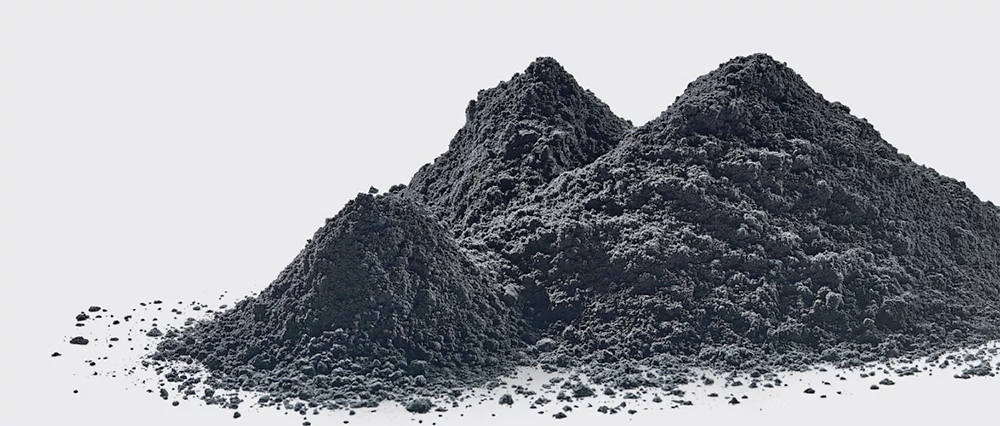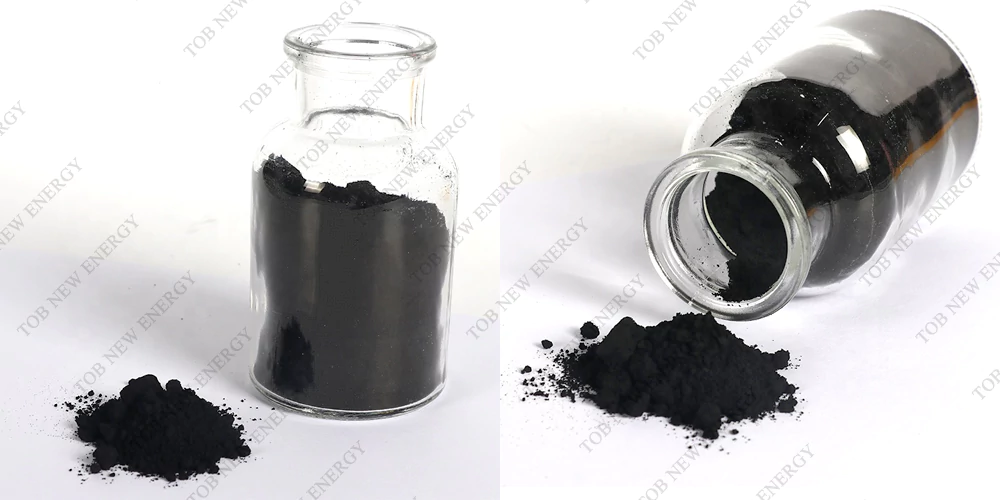Lithium-ion Battery Anode Material Classification
As one of the key materials for lithium-ion batteries, negative electrode materials need to meet multiple conditions.
With technological progress and industrial upgrading, the types of anode materials are also increasing, and new materials are constantly being discovered.
The types of anode materials can be divided into carbon and non-carbon. Carbon includes natural graphite, artificial graphite, mesophase carbon microspheres, hard carbon, soft carbon, etc. Non-carbon categories include silicon-based materials, titanium-based materials, tin-based materials, lithium metal, etc.

1. Natural graphite
Natural graphite is mainly divided into flake graphite and microcrystalline graphite. Flake graphite exhibits higher reversible specific capacity and first-cycle Coulombic efficiency, but its cycle stability is slightly poor. Microcrystalline graphite has good cycle stability and rate performance, but its Coulombic efficiency is low in the first week. Both graphites face the problem of lithium precipitation during fast charging.
For flake graphite, coating, compounding and other methods are mainly used to improve the cycle stability and reversible capacity of phosphorus flake graphite. Low temperature makes Li+ diffuse slowly in phosphorus flake graphite, resulting in low reversible capacity of phosphorus flake graphite. Pore creation can improve its low-temperature lithium storage performance.
The poor crystallinity of microcrystalline graphite makes its capacity lower than that of flake graphite. Compounding and coating are commonly used modification methods. Li Xinlu and others coated the surface of microcrystalline graphite with phenolic resin thermally cracked carbon, increasing the Coulombic efficiency of microcrystalline graphite from 86.2% to 89.9%. At a current density of 0.1C, its discharge specific capacity does not decay after 30 charge-discharge cycles. Sun Y.L. et al. embedded FeCl3 between the layers of microcrystalline graphite to increase the reversible capacity of the material to ~800 mAh g-1. The capacity and rate performance of microcrystalline graphite are worse than that of phosphorus flake graphite, and there are fewer studies compared to phosphorus flake graphite.
2. Artificial graphite
Artificial graphite is made from raw materials such as petroleum coke, needle coke, and pitch coke through crushing, granulation, classification, and high-temperature graphitization processing. Artificial graphite has advantages in cycle performance, rate performance, and compatibility with electrolytes, but its capacity is generally lower than natural graphite, so the main factor that determines its value is capacity.
The modification method of artificial graphite is different from that of natural graphite. Generally, the purpose of reducing the graphite grain orientation (OI value) is achieved through the reorganization of the particle structure. Usually, a needle coke precursor with a diameter of 8 to 10 μm is selected, and easily graphitizable materials such as pitch are used as the carbon source of the binder, and are processed in a drum furnace. Several needle coke particles are bonded to form secondary particles with a particle size D50 ranging from 14 to 18 μm, and then graphitization is completed, effectively reducing the OI value of the material.
3. Mesophase carbon microspheres
When asphalt compounds are heat treated, a thermal polycondensation reaction occurs to generate small anisotropic mesophase spheres. The micron-sized spherical carbon material formed by separating the mesophase beads from the asphalt matrix is called mesophase carbon microspheres. The diameter is usually between 1 and 100 μm. The diameter of commercial mesophase carbon microspheres is usually between 5 and 40 μm. The ball surface is smooth and has a high compaction density.
Advantages of mesophase carbon microspheres:
(1) Spherical particles are conducive to the formation of high-density stacked electrode coatings, and have a small specific surface area, which is conducive to reducing side reactions.
(2) The carbon atomic layer inside the ball is arranged radially, Li+ is easy to intercalation and deintercalation, and the large current charge and discharge performance is good.
However, repeated intercalation and deintercalation of Li+ at the edges of mesocarbon microspheres can easily lead to peeling and deformation of the carbon layer, causing capacity fading. The surface coating process can effectively inhibit the peeling phenomenon. At present, most research on mesophase carbon microspheres focuses on surface modification, composite with other materials, surface coating, etc.

4. Soft carbon and hard carbon
Soft carbon is easily graphitizable carbon, which refers to amorphous carbon that can be graphitized at high temperatures above 2500°C. Soft carbon has low crystallinity, small grain size, large interplanar spacing, good compatibility with electrolyte, and good rate performance. Soft carbon has a high irreversible capacity during the first charge and discharge, a low output voltage, and no obvious charge and discharge platform. Therefore, it is generally not used independently as a negative electrode material, but is usually used as a coating or component of the negative electrode material.
Hard carbon is carbon that is difficult to graphitize and is usually produced by thermal cracking of polymer materials. Common hard carbons include resin carbon, organic polymer pyrolytic carbon, carbon black, biomass carbon, etc. This type of carbon material has a porous structure, and it is currently believed that it mainly stores lithium through Li+ reversible adsorption/desorption in micropores and surface adsorption/desorption.
The reversible specific capacity of hard carbon can reach 300~500mAhg-1, but the average redox voltage is as high as ~1Vvs.Li+/Li, and there is no obvious voltage platform. However, hard carbon has a high initial irreversible capacity, lagging voltage platform, low compaction density, and easy gas generation, which are also its shortcomings that cannot be ignored. Research in recent years has mainly focused on the selection of different carbon sources, control processes, compounding with high-capacity materials, and coating.
5. Silicon-based materials
Although graphite anode materials have the advantages of high conductivity and stability, their development in energy density is close to their theoretical specific capacity (372mAh/g). Silicon is considered one of the most promising anode materials, with a theoretical gram capacity of up to 4200mAh/g, which is more than 10 times greater than graphite materials. At the same time, the lithium insertion potential of Si is higher than that of carbon materials, so the risk of lithium precipitation during charging is small and safer. However, the silicon anode material will undergo a volume expansion of nearly 300% during the process of intercalation and deintercalation lithium, which greatly limits the industrial application of silicon anodes.
Silicon-based anode materials are mainly divided into two categories: silicon-carbon anode materials and silicon-oxygen anode materials. The current mainstream direction is to use graphite as the matrix, incorporate 5% to 10% mass fraction of nano-silicon or SiOx to form a composite material, and coat it with carbon to suppress particle volume changes and improve cycle stability.
Improving the specific capacity of negative electrode materials is of great significance to increasing energy density. At present, the mainstream application is graphite-based materials, whose specific capacity has exceeded its theoretical capacity upper limit (372mAh/g). Silicon materials of the same family have the highest theoretical specific capacity (up to 4200mAh/g), which is more than 10 times that of graphite. It is one of the lithium battery anode materials with great application prospects.
|
Anode |
Specific capacity(mA.h/g) |
First cycle efficiency |
Tap density(g/cm3) |
Cycle life |
Safety performance |
|
Natural graphite |
340-370 |
90-93 |
0.8-1.2 |
>1000 |
Average |
|
Artificial graphite |
310-370 |
90-96 |
0.8-1.1 |
>1500 |
Good |
|
MCMB |
280-340 |
90-94 |
0.9-1.2 |
>1000 |
Good |
|
Soft carbon |
250-300 |
80-85 |
0.7-1.0 |
>1000 |
Good |
|
Hard carbon |
250-400 |
80-85 |
0.7-1.0 |
>1500 |
Good |
|
LTO |
165-170 |
89-99 |
1.5-2.0 |
>30000 |
Excellent |
|
Silicon-based materials |
>950 |
60-92 |
0.6-1.1 |
300-500 |
Good |
Currently, silicon-based anode technologies that can be industrialized are mainly divided into two categories. One is silica, which is mainly divided into three generations: 1st generation silica (silicon oxide), 2nd generation pre-magnesium silica, and 3rd generation pre-lithium silica. The second is silicon carbon, which is mainly divided into two generations: the first generation is sand-ground nano silicon mixed with graphite. Generation 2: CVD method to deposit nano-silica onto porous carbon.
6. Lithium titanate
Lithium titanate (LTO) is a composite oxide composed of metallic lithium and low-potential transition metal titanium. It belongs to the spinel type solid solution of the AB2X4 series. The theoretical gram capacity of lithium titanate is 175mAh/g, and the actual gram capacity is greater than 160mAh/g. It is one of the currently industrialized anode materials. Since lithium titanate was reported in 1996, academic circles have been enthusiastic about its research. The earliest reports of industrialization can be traced back to the 4.2Ah lithium titanate anode power battery released by Toshiba in 2008, with a nominal voltage of 2.4V and an energy density of 67.2Whkg-1 (131.6WhL-1).
Advantage:
(1) Zero strain, the lithium titanate unit cell parameter a=0.836nm, the intercalation and deintercalation of lithium ions during charge and discharge has almost no impact on its crystal structure, avoiding structural changes caused by material expansion and contraction during charge and discharge. As a result, it has extremely high electrochemical stability and cycle life.
(2) There is no risk of lithium precipitation. The lithium potential of lithium titanate is as high as 1.55V. No SEI film is formed during the first charge. It has high first-time efficiency, good thermal stability, low interface impedance, and excellent low-temperature charging performance. It can be charged at -40°C.
(3) A three-dimensional fast ion conductor. Lithium titanate has a three-dimensional spinel structure. The space for lithium insertion is much larger than the spacing between graphite layers. The ionic conductivity is one order of magnitude higher than that of graphite materials. It is especially suitable for high-rate charging and discharging. However, its specific capacity and specific energy density are low, and the charging and discharging process will cause the electrolyte to decompose and bloat.
At present, the commercial volume of lithium titanate is still very small, and its advantages over graphite are not obvious. In order to suppress the flatulence phenomenon of lithium titanate, a large number of reports are still focused on surface coating modification.
7. Metal lithium
Metal lithium anode is the earliest lithium battery anode studied. However, due to its complexity, past research progress has been slow. With the advancement of technology, research on metal lithium anodes is also improving. The metallic lithium anode has a theoretical specific capacity of 3860mAhg-1 and a supernegative electrode potential of -3.04V. It is an anode with extremely high energy density. However, the high reactivity of lithium and the uneven deposition and desorption process during charging and discharging lead to pulverization and lithium dendrite growth during the cycle, causing rapid degradation of battery performance.
In response to the problem of metallic lithium, researchers have adopted methods to inhibit the growth of dendrites in the lithium anode to improve its safety and cycle life, including the construction of artificial solid electrolyte interface films (SEI films), lithium anode structural design, electrolyte modification and other methods.
8. Tin-based materials
The theoretical specific capacity of tin-based materials is very high, and the theoretical specific capacity of pure tin can reach 994mAh/g. However, the volume of tin metal will change during the process of intercalation and deintercalation lithium, resulting in a volume expansion of more than 300%. The material deformation caused by this volume expansion will produce a large impedance inside the battery, causing the battery cycle performance to deteriorate and the specific capacity to decay too quickly. Common tin-based negative electrode materials include metallic tin, tin-based alloys, tin-based oxides, and tin-carbon composite materials.